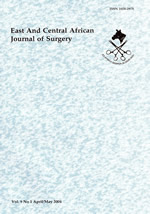
|
East and Central African Journal of Surgery
Association of Surgeons of East Africa and College of Surgeons of East Central and Southern Africa
ISSN: 1024-297X
EISSN: 1024-297X
Vol. 9, No. 2, 2004, pp. 89-95
|
 Bioline Code: js04048
Bioline Code: js04048
Full paper language: English
Document type: Research Article
Document available free of charge
|
|
|
East and Central African Journal of Surgery, Vol. 9, No. 2, 2004, pp. 89-95
| en |
Sutured and Open Clean-Contaminated and Contaminated Laparotomy Wounds at Muhimbili National Hospital: A Comparison Of Complications.
E.V. Ussiri, C.A. Mkony, M.R. Aziz.
Abstract
Background: Whether to close or leave open an abdominal incision wound depends on the degree of wound contamination at the end of operation. The aim of this study was to compare the complication rates between delayed primary closure and primarily closed laparotomy wounds for clean-contaminated and contaminated abdominal operations.
Methods: Eighty-six patients undergoing laparotomy were included in a randomized clinical trial. Patients were randomized to have their wounds left open or closed primarily. In this study, all patients received Ceftriaxone Sodium (Powercef ®) as a prophylactic antibiotic at the time of induction of anaesthesia.
Results: There was a statistically significant difference (p=0.002) in wound infection rate between those wounds left open (30.2%) and those closed primarily (2.1%). It required a longer duration of time for dressing those wounds left open compared to those closed primarily, The average duration for wound dressing was 16 days for open wounds compared to 11 days for primarily closed ones (p=0.0002). There was no significant difference in the development of wound dehiscence between the two groups (p>0.05). No death was related to wound complication.
Conclusion: Clean-contaminated and contaminated laparotomy wounds should be closed primarily if no gross spillage of visceral contents occurs during operation and a patient receives prophylactic antibiotics.
|
| |
© Copyright 2004 - East and Central African Journal of Surgery
|
|
